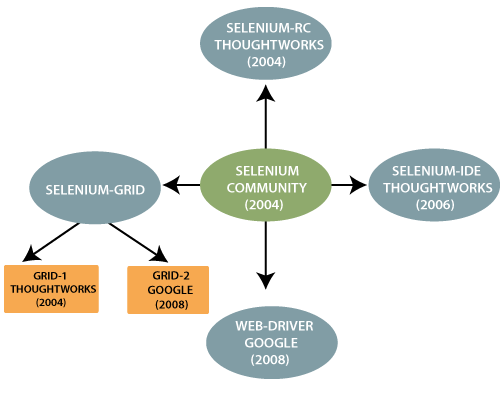Selenium Tool Suite
The selenium tool suite is a combination of multiple software tools, and the entire tools having a different approach to support automation testing. Selenium test tool suites are as follows-
- Selenium –IDE [Integrated Development Environment ]
- Selenium –RC [Remote Control]
- Selenium Web Driver
- Selenium Grid

1. Selenium -IDE [Integrated Development Environment]:
Thought Works Company introduces selenium IDE in 2006 andimplemented in the Firefox browser, which provides record and playback functionality to the test scripts. Selenium-IDE is the simplest tool of Selenium community. Selenium-IDE allows software testers to export recorded scripts in many languages like HTML, Java, Ruby, PHP, Python, C#, and Test-NG.
Selenium–IDE supports six locators, i.e., – Id, Name, X Path, CSS Selector, Link Text, DOM.
2. Selenium-RC [Remote Control]:
Selenium RC is the first open-source tooling in selenium community which is introduced by Thought Works Company in 2004. Selenium RC doesn’t have a record and playback features. Selenium RC cannot execute test script with selenium server. Selenium –RC supports multiple languages (java, C++, python), multiple operating systems (Windows, Linux), and multiple browsers (internet explorer, Google Chrome).
3. Selenium Web-Driver:
Selenium Web-Driver is also called Selenium -2, and Google introduced it in 2008. Selenium Web-drivers is just a collection of core java interface. In comparison to Selenium RC, Selenium web driver is more powerful and faster tool because it directly calls to the web browser. Web-driver supports multiple browsers, multiple operating systems, and multiple languages.
4. Selenium Grid:
Selenium Grid is also an important tool of Selenium Suite, which allows us to run our tests script on different machines against different browsers simultaneously. Selenium Grid proceeds from the Hub-Node Architecture to achieve parallel execution of test scripts.
Selenium Grid is divided into two parts-
- Grid-1:- Grid-1 introduced by Thought works company in 2004.
- Grid-2:- Google Company introduced it in 2008.